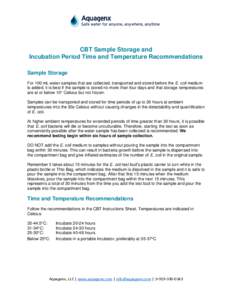 Date: 2016-08-12 12:36:23Eggs Cell biology Laboratory equipment Medical equipment Incubator Poultry Escherichia coli Temperature Egg incubation Bacteriological water analysis | |  CBT Sample Storage and Incubation Period Time and Temperature Recommendations Sample Storage For 100 mL water samples that are collected, transported and stored before the E. coli medium is added, it is best if the sampl CBT Sample Storage and Incubation Period Time and Temperature Recommendations Sample Storage For 100 mL water samples that are collected, transported and stored before the E. coli medium is added, it is best if the sampl
Add to Reading ListSource URL: www.aquagenx.comDownload Document from Source Website File Size: 270,22 KBShare Document on Facebook
|

